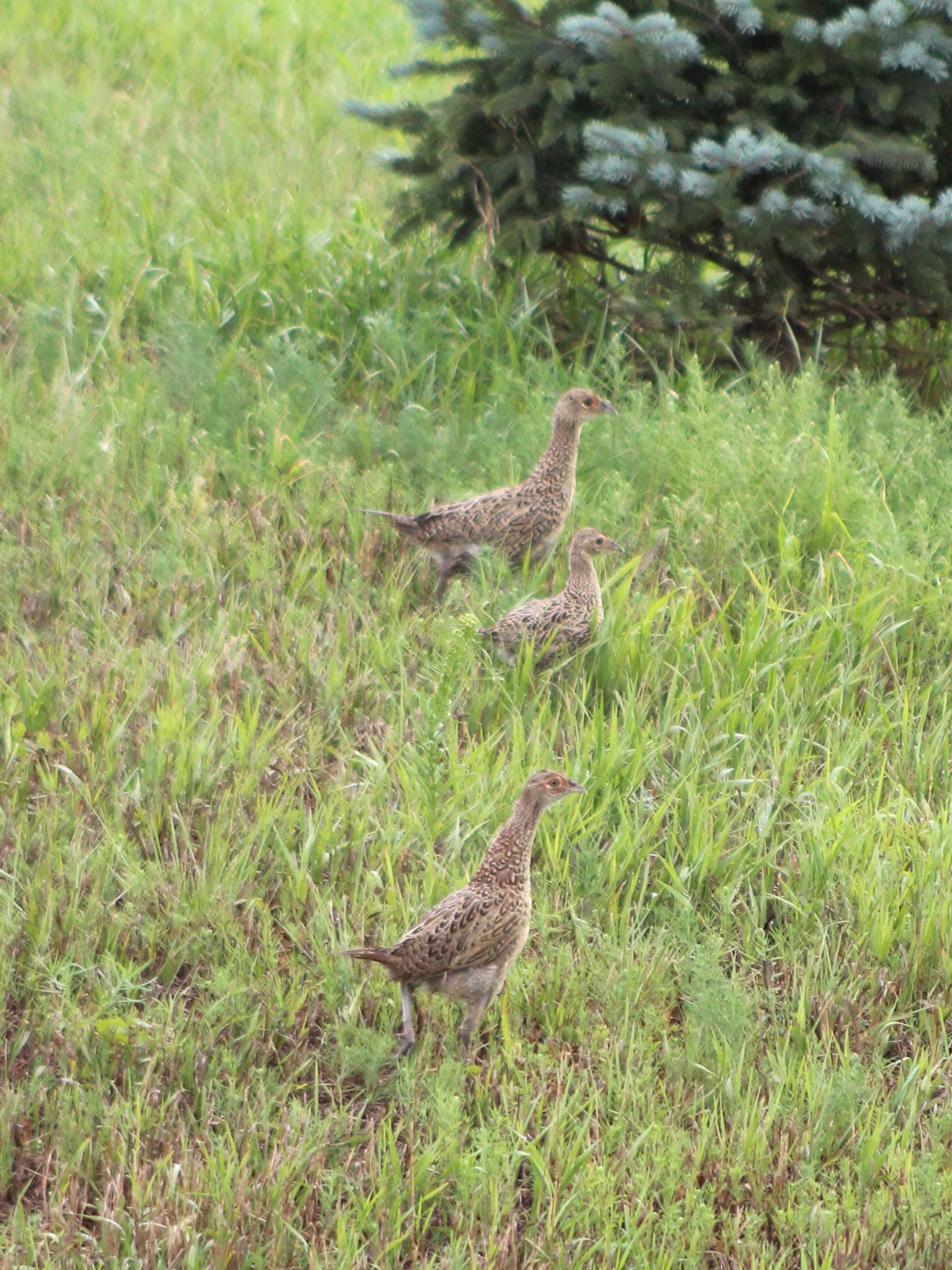
Those on the lookout should start seeing broods of pheasant chicks like these in the ditches of North Dakota’s gravel roads throughout the birds’ primary ranges throughout the next few weeks. Simonson Photo.
By Nick Simonson
While drought conditions persist across much of North Dakota, with severe levels in the west-central portion of the state around Lake Sakakawea, much of the state has received some badly needed rain which is not only good for foliage and farming, but hopefully this year’s crop of pheasant chicks as well.
While some downpours – like a mid-June storm near Steele, N.D. that dropped more than 5 inches of rain in a localized area – may have hampered nesting efforts, gentler rains have helped hedge a severe drought and will likely spur insect populations to help feed new upland birds on the landscape. And while early reports of broods are lacking, Upland Game Biologist RJ Gross with the North Dakota Game and Fish Department (NDG&F) is hopeful for late nesting efforts carrying upland populations into fall.
“I’ve only heard a few [broods being seen] in the far southwest corner of the state, other than that I haven’t heard of a single one and I’ve been asking our district staff and people aren’t seeing any,” Gross said of early anecdotal reports, “it’s concerning so far but I am still going to remain hopeful, and hopefully we can have a strong second half of the summer, and see what our brood surveys tell us,” he concludes.
Recent rainfall in many areas was what was required to spur insects like beetles, and other edibles such as spiders and slugs which provide the protein and other nutrients pheasant chicks require to develop feathers, grow and regulate their body temperatures. In other places, where the rainfall was heavy, the precipitation may have been too much, and those areas may require a second nesting attempt by pheasant hens to pull off a hatch, when initial spots were inundated with water, or the eggs were lost due to other environmental factors. Gross explains that there are no second broods in North Dakota, and once chicks hatch, a hen’s nesting mission is effectively completed, even if those chicks die. Only in the situation where the eggs are destroyed before hatching, be it from untimely rains, predators or other reasons, will the hen consider re-nesting, and sometimes they will not due to extreme environmental conditions or a weakened state.
“A pheasant hen will not have a second hatch or a second brood. If a hen lays a clutch of eggs and those eggs at any time get destroyed, she will try to re-nest. Now every time she does that and depending on how late it gets, the number of eggs will be reduced,” Gross explains, adding, “in drought conditions, sometimes in research it has been shown that they will not re-nest, just because their body condition isn’t as good as it should be.”
Typically, hens begin laying eggs and nesting in mid-May and the peak of the hatch in North Dakota usually occurs between June 10 and June 15. In the ten-day to two-week period following that peak, chicks will forage in dense grass and forbs for insects with the hen often nearby. After that time, Gross expects that more people will begin seeing young birds out and about along roadsides in the morning, and the upcoming Fourth of July holiday weekend is when many anecdotal reports of first broods begin making their way to NDG&F agents.
On a first nesting attempt, a hen will lay around a dozen eggs. On a second attempt that number drops to eight or so. In subsequent efforts, the egg count can decline to four or less, and those smaller nests may occur as late as August. Oftentimes in late summer, individuals will observe pheasant broods that are larger in number and in size, with smaller broods of tinier birds alongside them, or just down the road. The subsequent set of birds is not a second hatch from the same hen, but rather a successful, later nesting attempt by another hen that did not lay as many eggs and did so later in the nesting period. It’s these smaller broods that can save a hunting season, when conditions are not good during a first nesting attempt by hens in a given area.
“Last year, going through our hunter-harvested wings, there was a strong end-of-July hatch that came through, which is always good to see,” Gross stated, referencing 2015 as another notable nesting season where a strong second attempt bumped up bird numbers for the summer roadside brood count and helped provide hunters with more pheasants to pursue that fall.
This year’s summer roadside brood count will be conducted by Gross and other NDG&F agents from July 20 until Aug. 31. Employees will drive along assigned 20-mile routes, counting the number of adult upland birds including pheasants, sharptailed grouse and partridge, that they see along the roadside. In addition to the tallies of birds seen per 100 miles and numbers of birds in each brood, they’ll record GPS location for more in-depth information in the program which has run for more than six decades in the Roughrider State, providing a strong data set for comparison, year-over-year.
The results are typically released in early September and compared against historical and most recent 10-year averages to provide hunters with an idea of what to expect in the field this fall.
